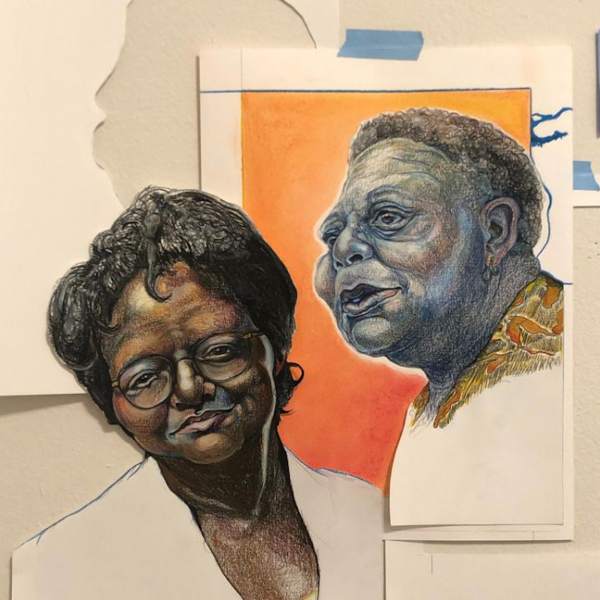For Lily Grace Fast, a sophomore at the School of the Art Institute of Chicago, a summer road trip that centered on civil rights history was a privilege she feels called upon to continue to examine.
“The importance and the weight of the places we went to felt understated given the fact that they were simply stops along a road trip for a family who had the privilege to take such a trip amidst the pandemic and the civil rights moment we’re currently living in,” said Fast of the trip, which began in California and continued on through Arizona, Texas, Oklahoma, Arkansas, Tennessee, Alabama and Kentucky. “We learned history from those who lived it. We met with incredible spirited women who spoke of things most only know through textbooks, if even through that.”
For student-centered exploratory resources on the Japanese American internment camps, such as virtual visits, see our curated collection for educators and learners alike.
Michael DiMaggio, Fast’s stepdad and KnowledgeWorks’ vice president of strategic partnerships and development, organized the trip with the sole purpose of expanding his family’s understanding of systemic racism and the biases inherent in our systems. DiMaggio is half Japanese-Filipino.
“I wanted our family to understand the role that Whiteness plays in the system,” said DiMaggio. “Many people can go through their whole lives without being touched by racism. It was important to help them understand that not everybody has that luxury, to not have to worry about it. People live with this every day. I was grateful that my family would be comfortable with being uncomfortable. To be sad, to cry, to be outraged.”

Fast and the rest of her family had the opportunity to speak with Sybil Jordan Hampton, one of the first Black students to integrate and graduate from Central High School in Little Rock, Arkansas, and JoAnne Bland, who marched across the Edmund Pettus Bridge in Selma, Alabama, all three times even after experiencing Bloody Sunday. They learned from Robin Loucks, a White student who attended Central High School in 1957 with the Little Rock Nine, and Sheila Washington, founder and director of the Scottsboro Boys Museum and Cultural Center. Fast described all four women’s words as containing “the promise of change.”
To learn and help students learn more about Brown v. Board, visit our curated student-centered resources that allow learners to explore the concepts, people and locations of Brown v. Board.
DiMaggio, whose grandmother was Japanese, made sure to include a visit to a Japanese internment camp in the Arkansas Delta where little remains except a statue and a cemetery in a cotton field. They also visited Tulsa’s Greenwood District, known as Black Wall Street, where Fast and her family found the memorial – a placard near an overpass – woefully inadequate for the lives and livelihoods lost there, especially in contrast with the Alfred P. Murrah Federal Building Memorial recognizing the Oklahoma City bombing as the “largest act of domestic terrorism” when nearly half as many lives were lost.
“Before the trip, I do not think anything could have prepared me for what I saw,” said Morgan Gill, a junior at Cal State University of Long Beach, Fast’s cousin and DiMaggio’s niece, who was also on the trip. “I was surprised most by how much I didn’t know, even as a student of AP History.”
DiMaggio notes that the questions that kept surfacing for Gill and Fast were why so much of what they were hearing and seeing was new to them, and not something they’d been taught in school. For Gill, her outrage over what she hadn’t learned in school and learned instead on the trip continues to be a source of motivation.
“It’s infuriating that in the 21st century, history is only repeating itself,” Gill said. “But I am learning how to stand up for myself more: standing up for my beliefs and refuting racism. I have had difficult conversations, listened to others and educated myself. However, this work never ends. It is important that I devote my whole life to continuing to learn about what matters, about the lives of others who do not deserve to be marginalized.”
To understand present problems, we have to consider the weight of history. For Black people that involves a deep history of violence. Educators can use our curated resources about two massacres of the Jim Crow Era to help learners understand the weight of history in racial reckoning.
For DiMaggio, continuing the conversations begun on the trip means continuing to grapple with discomfort, pain and ignorance.
“No matter what is happening now, these are not conversations that are unique to this time. Everything that we’re seeing in the United States right now is intentional – over 400 years of intentional actions by people in charge,” said DiMaggio. “This is something that if we’re going to seriously address and tackle this, we have to make it a part of our life’s work.”
Fast seems committed to her role in a more just future.
“We learned that small actions matter in working towards something bigger,” said Fast. “If we all thought that we, as just one person, couldn’t do anything for the world, where would we be? John Lewis said, ‘When you lose your sense of fear, you’re free.’ We are not taught to face our fears with grace; we are not taught about the people who did just that, people like Sybil Jordan Hampton and JoAnne Bland. The power of one person to disturb the status quo activates a humane agency; it shifts our thinking. Like the good Samaritan in one of Martin Luther King, Jr.’s sermons, you have to ask yourself not what would happen to you if you help another, but what would happen to another if you didn’t help.”